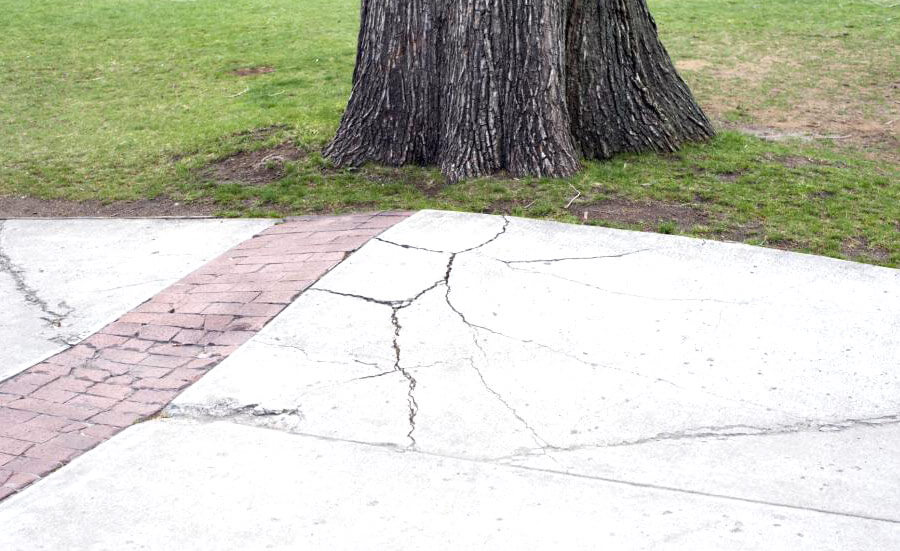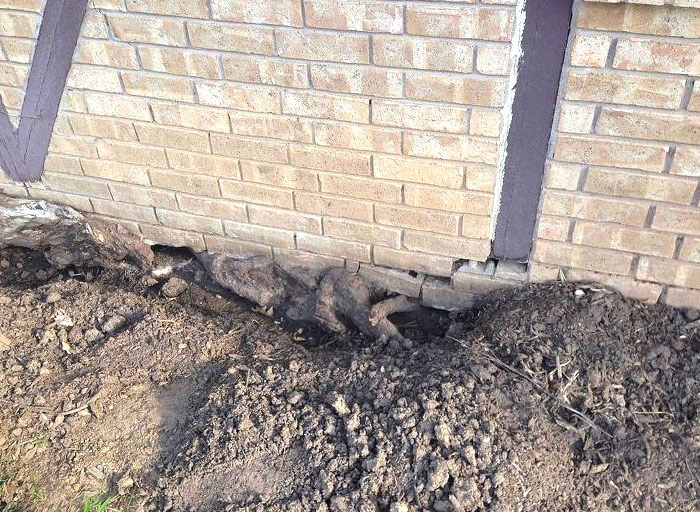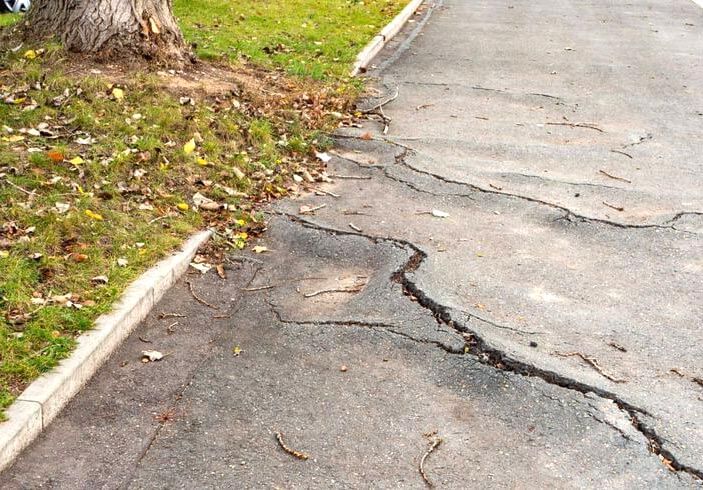Tree root damage is a common problem for property owners in Australia as we have a lot of native species with invasive roots. When trees grow, their roots can extend far beyond the tree’s canopy, potentially causing damage to surrounding structures such as sidewalks, driveways, and even the foundation of nearby buildings. The million-dollar question is, who is responsible for this damage?

Determining liability
In many cases, determining liability for tree root damage can be a complex issue. Property owners may argue that the tree is the municipality’s responsibility, while municipalities may argue that the owner is responsible for maintaining the area around the tree.
I recently spoke with a Sydney resident not long ago, who had their front brick fence damaged by the roots of a city tree; the Council claims it’s the homeowner’s job to trim the roots and not their responsibility.
What is damaged, and how bad is it
What has been damaged and the extent of the damage may also come into play when determining liability. For example, if a council tree has pushed over your letterbox, they will not pay to replace it. If the tree is damaging the foundations of your home, this is a different story entirely, and they will more than likely cover the repair cost.
Overall, it is important to approach the issue of tree root damage with a clear understanding of the responsibilities of property owners and municipalities. By being knowledgeable about the issue, property owners and municipalities can work together to prevent and address tree root damage fairly and efficiently.

Table of contents
ToggleLegal Aspects
Property Owner's Responsibility
The responsibility typically falls on the property owner where the tree is located. Property owners have a legal duty to maintain their trees and ensure that they do not cause damage to neighbouring properties. This includes regularly inspecting the tree for signs of damage or disease and taking appropriate action to prevent harm to others.
If a property owner fails to maintain their trees and causes damage to a neighbouring property, they can be held liable for the costs of repairs and any other damages resulting from the incident.
However, if your neighbour alerts you to the damage being caused in a timely manner and the issue compounds, it could be argued that they need to maintain their property, so it becomes a little murky.
Neighbour's Responsibility
The responsibility for tree root damage generally falls on the shoulders of whose property the tree is on. If a neighbour’s tree roots cause damage to a property, the affected property owner may be able to hold their neighbour liable for the repairs.
However, the neighbour must have known about the tree’s potential to cause damage and failed to take action to prevent it. If the neighbour did not know or could not have reasonably known that their tree posed a risk, they may not be held responsible for the damage.
City's Responsibility
In some areas, cities or municipalities may be responsible for maintaining trees on public property. If a city-owned tree causes damage to private property, the affected property owner may be able to file a claim with the city for compensation, but they are not going to give up public money easily.
You may need to go down the road of getting an arborist to inspect the tree and dig around to the roots to determine whether the city’s tree was, in fact, the cause. They will need to present their findings in a report. Arborist reports cost $550 on average. You may also need to get a building company in to assess the damage and cost of repairs to satisfy the council.
Understanding Signs of Tree Root Damage
It can be difficult to tell if a tree’s roots are damaging your property until it is too late, but there are a couple of things to look for:
- Lifting driveway: If your driveway has begun to lift, digging around the area is important to find the cause. The quicker you can stop the damage, the cheaper the repair.
- Blocked drains: Get your plumber to identify where a tree is blocking drains. If it is close to the foundations of your home, this could be an early warning sign it’s time for some root pruning or installing a root guard.
- Cracks in pavement or walls: If you see a crack begin to open up in your home, it could be caused by several things, one of which is tree roots. You will need to investigate some more.

Prevention Strategies
Regular Inspection
To prevent tree root damage, regular inspection of the trees is essential. Inspecting the trees at least once a year is recommended to ensure that they are healthy and not causing any damage to the surrounding areas. During the inspection, look for root damage signs, such as pavement or wall cracks. If any issues are found, take immediate action to address them.
Proper Planting and Care
Proper planting and care of trees can also help prevent root damage. When planting trees, choosing the right location and soil type is important and planting the tree at the appropriate depth. It is also important to provide adequate water and nutrients to the tree, and to prune it regularly to maintain its health and shape. Proper care can help ensure that the tree’s roots grow in a healthy manner and do not cause damage to surrounding structures as they search for moisture.
Installing a root barrier
Another option is to use a root barrier to prevent the roots from growing into the area. The barrier can be made of various materials, such as plastic or metal, and should be installed by a professional.
Seeking Professional Help
If you are unsure how to properly care for your trees or suspect there may be root damage, it is important to seek professional help. A certified arborist can help assess the health of your trees and recommend the best course of action to prevent root damage. They can also guide you on proper planting and care techniques and help identify any potential issues before they become major problems.
Dealing with Tree Root Damage
Repairing Damage
When dealing with tree root damage, repairing the damage is the first step. This may involve removing the damaged concrete or pavement and replacing it with new material. It is important to ensure that the new material is properly compacted to prevent future damage.
Removing the Tree
Removing the tree may be the best solution to prevent further damage. This is particularly true if the tree is causing extensive damage or if it is in a location where it is likely to cause damage in the future.
It is important to note that a professional should remove a tree. This will ensure the tree is removed safely and the roots properly removed to prevent future growth.
Most Councils allow trees growing within 3m of the foundations of a home to be removed without a permit for this very reason. You will need to consult your local Council’s Tree Preservation Order for details on local laws and permits.
Insurance Coverage
Insurance coverage for tree root damage can vary depending on the policy and the specific circumstances. Generally, damage caused by roots is not covered by standard homeowner’s insurance policies.
However, if the damage was caused by a tree on a neighbour’s property, the neighbour may be held responsible for the damage. In this case, the neighbour’s insurance policy may cover the cost of repairs.
Reviewing the specific insurance policy and speaking with an insurance agent to determine what coverage is available for tree root damage is important.
FAQ's
In Australia, laws pertaining to tree root damage vary by state. Generally, property owners are responsible for maintaining their own property, including any trees on it. If a tree on one’s property causes damage to a neighbour’s property, the owner of the tree may be held liable for the cost of repairs.
If a neighbour’s tree roots are causing damage to your property, you may be able to take legal action. However, it is recommended to first try and resolve the issue through communication with your neighbour. If this fails, legal action may be pursued.
Guidelines for planting trees near property lines vary by state and local council regulations. Generally, planting trees at a safe distance from property lines is recommended to avoid potential damage to neighbouring properties.
Several preventative measures can be taken to avoid tree root damage, such as planting trees safely from property lines, using root barriers, and regular tree maintenance.
Cutting a neighbour’s tree roots without permission may result in legal action being taken against you. It is recommended to first communicate with your neighbour and seek their permission before acting.






